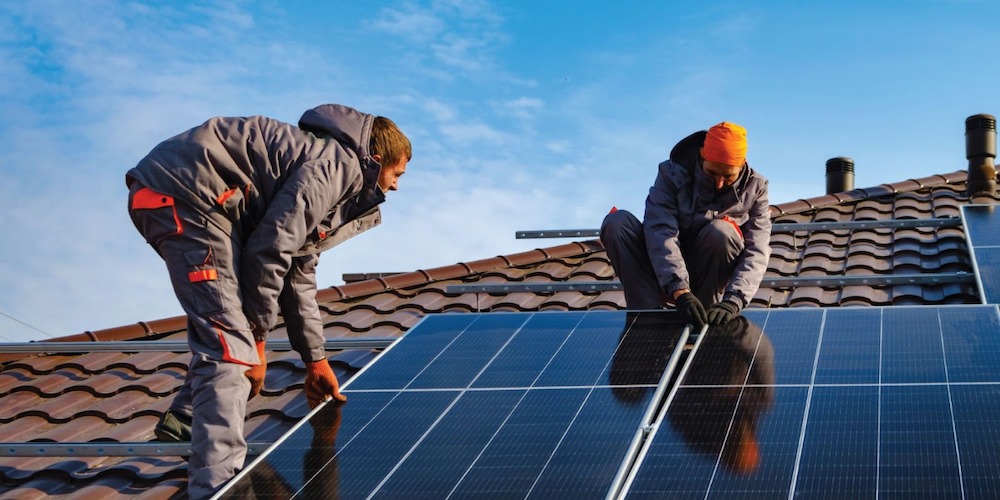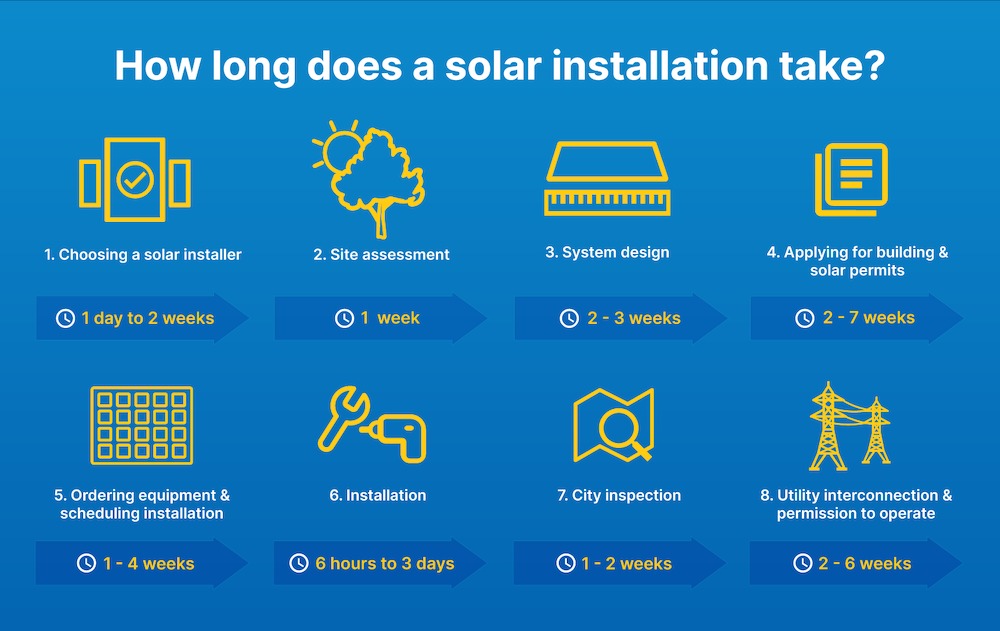Updated 1 year ago
How long does a solar panel installation take?
Written by
Jamie Smith

Find out what solar panels cost in your area
Installing solar panels doesn't happen overnight.
From beginning to end, there are multiple steps that go into installing a solar system to your home. Besides the actual installation, the process involves applications, paperwork, approvals, and more.
Expect it to take between two and six months before your solar installation is complete and you’re cleared to use them.
Let’s take a closer look at this process and provide you with a timeline, including a detailed description of each step.
Key takeaways
-
Solar panel installations will take somewhere between two and six months to complete.
-
The actual installation is actually the shortest part of the process – ranging from a few hours to a few days to accomplish.
-
Applying and getting approval for a permit is the longest part of the process, which can take up to two months to complete.
-
After your system is installed, you must get an inspection done by a representative from your city or local municipality and then have your utility company send someone to interconnect your system to the grid.
-
Picking a reputable solar company to guide you through this process is crucial, so make sure you find a top-rated local pro.
How long does a solar installation take?

While solar panels can be installed in just a few hours, the entire solar installation process can actually take anywhere from two to six months. Six months may seem like a long time, but it’s well worth it for 25 years of electricity bill savings!
You can think of the installation process in three parts:
Before installation, which includes choosing an installer and the planning and preparation for the system.
Installation, when the solar company is on your roofing, putting the panels in place
After installation, when the panels are installed and waiting for the necessary permissions to turn on.
Before installation
Before any panels are installed to your roof, there are a few steps that need to be taken, including choosing an installer, a site assessment, designing the system, applying for permits, and ordering equipment.
1.) Choosing an installer
Time: 1 day - 2 weeks
The first thing you need to do is choose a good solar installer.
This step is arguably the most important part of the process. The company you work with will make or break your experience with installation. Who you choose can affect how much you pay, and the overall quality of the work on your roof.
When trying to find a reputable installer, we recommend finding an installer that:
Has been in business for at least 5 years
Have a NABCEP certified installer
Has positive customer reviews
You should try to find multiple installers in your area and obtain quotes from them so you can compare. To be safe, get a minimum of three quotes – but don’t be afraid to get more! Getting multiple solar quotes lets you get a feel for each company and will get you the best price on your installation.
This part of the process can span over a few days or weeks, depending on how much luck you have in your search!
Researching a company can get stressful. Luckily, you can let SolarReviews do the hard part for you. We can connect you with the top-rated local solar installers in your area.
2.) Site assessment
Time: 1 week
So you found an installer. Great! Now the installer can perform a site assessment to make sure your roof is suitable for solar panels.
A representative from the solar company will come to your house to check out the condition, size, direction, and sun exposure to your roof. These are all important factors to make sure solar panels are right for your home.
The company will also determine if your roof can handle the weight of solar panels, as well as take a look at your electrical panel to see if you are in need of any upgrades or maintenance before the installation.
The actual assessment will only take a few hours, but to factor in scheduling the company to come to your home, we’ll give this step about a week-long time frame.
3.) System design
Time: 2 - 3 weeks
When your roof has been given the green light for solar, it’s time to design a system that’s perfect for your home.
A solar engineer will take care of the design part. Your electricity usage, inverter and solar panel wiring, local building code requirements, and utility requirements are all taken into account when designing your system.
This can take anywhere from two to three weeks on average, but it may take longer if your roof is more complex. All in all, the design stage for more complicated systems shouldn’t take much more than four weeks.
4.) Applying for building and solar permits
Time: 2 to 7 weeks
Since installing solar panels is a construction project, you need to have all of the proper permits before you can begin anything. The documentation you need can vary depending on what town you live in. Some areas have solar-specific permits while others have various building and electrical permits that you need.
The timeframe for getting the necessary permits will also vary depending on your municipality. It could take just weeks to get approval – or close to two months. The good news is your installer is the one who handles the paperwork.
This stage of pre-installation is the ‘not-so-fun' part. It can be a grueling, lengthy process, but it also needs to get done for your installation to proceed.
5.) Ordering equipment and scheduling installation
Time: 1 - 4 weeks
Once you get the O-K on your permits, your company can finally begin making moves to install your system. Your installer might have the equipment they need on-hand and can get to work right away.
In this case, you won’t have to wait for equipment to ship, but you might need to wait for an available day for the company to come out to your home to install. Just for scheduling purposes, we’ll give this stage about a week minimum.
If your installer needs to order supplies to start the installation, that will lengthen the process. It could take a few weeks for all the equipment to get delivered, especially if you run into any solar supply chain issues.
Heads up, battery buyers! You may need to wait even longer for installation if you are pairing your solar panel system with solar battery storage. Batteries are in high demand, and it can take a while to get your hands on one. You may need to wait a little (or a lot) longer for your battery equipment to be delivered.
Installation
Time: 6 hours - 3 days
It’s installation time! Believe it or not, your solar panel installation will actually be the shortest part of the whole process.
Installers will come to your home and do a lot of work on your roof; laying down the racking systems, panels, and the wiring of all your solar equipment.
Installing a solar system should only take a few hours to complete, pending that your installer doesn’t run into any major hiccups. However, if you’re installing a larger, more complex system – it might be a multi-day project. At most, a solar installation shouldn’t take more than a few days to complete.
After installation
The installation is finally complete – now what? There are a few more steps that need to be taken before your home is running on the sun.
1.) City inspection
Time: 1 - 2 weeks
The first order of business after having your solar panels installed is to have an inspection performed.
A local inspector will likely come to your home to make sure the system was installed properly and meets all of the correct building codes or regulations. This is a safety measure so any issues can be identified before your system is turned on.
Just like a site assessment, this part should only take a few hours at most, but it might take a week or so to schedule a time for the inspector to come.
2.) Interconnection process & permission to operate
Time: 2 - 6 weeks
Congratulations! You’ve made it to the final step!
Your utility company will need to interconnect your system to the grid and then give you permission to operate (PTO). Usually, a utility representative will come to your property, install a new electric meter that can properly track your solar energy production, and do a quick inspection.
Unfortunately, waiting for your utility to do this can take a while – up to a few weeks! However, once this is taken care of, you can begin using your panels!
Solar panel maintenance after your installation. Solar panels have no moving parts so they require very little maintenance and experience few failures. The angle of the solar panels and rain are usually enough to keep the panels clean. But, to have your panels operating at their very best you should go out of your way to clean them about twice per year.
Things to keep in mind for solar installations
Getting solar may seem like a hassle, but the benefits are definitely worth the wait! Here are a few things to keep in mind throughout your process:
Pick a reliable installer: The company you choose to perform your installation can really impact your experience. Make sure you choose a reliable installer that can handle any of your questions or concerns.
Have patience: Getting solar is not a speedy process and can take several months, depending on how the pre and post-installation process goes. Have patience; your investment in clean energy will be up and running before you know it!
Make sure you and your home are prepared: Make sure solar is a viable option for your home. This can pertain to your financial situation, your roof’s condition, and your state’s solar benefits.
Is your state good for home solar? Download our report on the Best Solar States of 2023 to find out!
Get started on your solar journey
Finding the right solar installer can seem like a daunting task, that’s what SolarReviews is here for!
We have a stacked list of reliable solar companies featuring hundreds of customer reviews for you to look through to make the right decision for yourself.
Want to find out if solar is right for your home? Use our solar calculator to find out more information on solar costs, savings, incentives, and more for your home!
Jamie is a Content Writer and researcher at SolarReviews. A recent graduate of La Salle University in Philadelphia, Jamie earned her B.S. in communications with a concentration in journalism, mass media, and public relations. Jamie has previously worked at a marketing company where she had the opportunity to highlight and promote small business owners through long-form stories and interviews. With a deep-rooted passion for creativity, Jamie stri...
Learn more about Jamie Smith